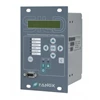For HV, MV and LV Distribution Systems and for Decoupling, Load shedding and Loss of main (Islading) Protection.
Main characteristics:
- Protection functions: 27(2), 27V1, 59(2), 59V2, 59N(2), ΔV/ΔT, 74TCS, BF, 52, 79, 81U/O(4), 81R(2), 86, 78, 25.
- Auxiliary power supply (24-110 Vdc / 48-230 Vac).
- 5 attempts of reclosing with 79 protection function (Recloser).
- Synchronism check: Voltage differences, frequency slip, angle differences, DLDB, DLLB, LLDB. (Function 25).
- Direct signalling/control of function 52 (Circuit Breaker) and function 79 (Recloser).
- Metalic box with high electromagnetic compatibility level (EMC) and wide range of operating temperatura.
- 5 oscillographic records, 20 fault reports and non volatile RAM memory: stores 200 events without power supply thanks to its internal RTC (Real Time Clock).








